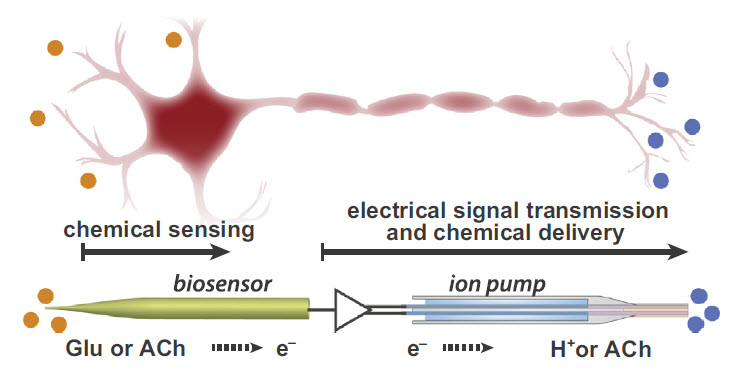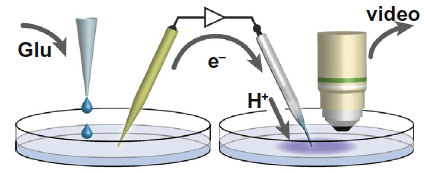Swedish scientists create an artificial neuron that mimicks an organic one
June 29, 2015

Chemical-to-electrical-to-chemical signal transmission. A conventional neuron (upper panel) senses chemical signals (orange circles), which trigger an electrical pulse of membrane depolarization (action potential) along the axon, causing chemical release at the axon terminals (blue circles). This process can be mimicked (lower panel) by a chemical biosensor (for glutamate or acetylcholine) connected to an axon-mimicking organic electronic ion pump that transmits electrons/ions and generates chemicals — forming an organic electronic biomimetic neuron. (credit: Daniel T. Simon et al./Biosensors and Bioelectronics
Scientists at Sweden’s Karolinska Institutet and Linköping University have built what they claim is a “fully functional neuron” that mimicks the functions of a human nerve cell.
The “organic electronic biomimetic neuron” combines a biosensor and ion pump. It senses a chemical change in one dish and translates it into an electrical/ionic signal that travels along an “axon” to a “synapse” and releases chemical signals in another dish, that then trigger another neuron, etc.

Glutamate drops are added to a dish containing a biosensor (green) that generates electronic signals (e–), which (via hardware/software) regulate hydrogen ion delivery (white tube) to another dish, where pH is monitored microscopically (video) (credit: Daniel T. Simon et al./Biosensors and Bioelectronics)
Such a device could eventually be miniaturized and implantable, says lead investigator Agneta Richter-Dahlfors, Karolinska Institutet professor of cellular microbiology. The research objective: improve treatments for neurological disorders, which are currently limited to traditional electrical stimulation.
Could the brain be analogous to a computer?
Countering skeptics, psychologist/neuroscientist Gary Marcus, writing in The New York Times June 27, says “yes” — but not a simplistic digital or analog computer. “The brain might consist of highly orchestrated sets of fundamental building blocks, such as ‘computational primitives’ for constructing sequences, retrieving information from memory, and routing information between different locations in the brain,” he says. One computational model he suggests: a field programmable gate array (FPGA), consisting of multiple types of “logic blocks” operating in parallel.
For example, the new technique could make it possible to remotely stimulate neurons based on specific chemical signals received from different parts of the body. Or physicians could artificially bridge damaged nerve cells and restore neural functions.
To find out, the scientists would next like to miniaturize this device to enable implantation into the human body and cause it to wirelessly release neurotransmitters in distant neurons, says Richer-Dahlfors. “Such auto-regulated sensing and delivery, or possibly a remote control, [could lead to] new and exciting opportunities for future research and treatment of neurological disorders.”
This study was published in the journal Biosensors & Bioelectronics. Funding was provided by Carl Bennet AB, VINNOVA, Karolinska Institutet, the Swedish Research Council, Swedish Brain Power, Knut and Alice Wallenberg Foundation, the Royal Swedish Academy of Sciences, and Önnesjö Foundation.
Karolinska Institutet | Artificial neuron mimicks function of human cells
Abstract of An organic electronic biomimetic neuron enables auto-regulated neuromodulation
Current therapies for neurological disorders are based on traditional medication and electric stimulation. Here, we present an organic electronic biomimetic neuron, with the capacity to precisely intervene with the underlying malfunctioning signalling pathway using endogenous substances. The fundamental function of neurons, defined as chemical-to-electrical-to-chemical signal transduction, is achieved by connecting enzyme-based amperometric biosensors and organic electronic ion pumps. Selective biosensors transduce chemical signals into an electric current, which regulates electrophoretic delivery of chemical substances without necessitating liquid flow. Biosensors detected neurotransmitters in physiologically relevant ranges of 5–80 µM, showing linear response above 20 µm with approx. 0.1 nA/µM slope. When exceeding defined threshold concentrations, biosensor output signals, connected via custom hardware/software, activated local or distant neurotransmitter delivery from the organic electronic ion pump. Changes of 20 µM glutamate or acetylcholine triggered diffusive delivery of acetylcholine, which activated cells via receptor-mediated signalling. This was observed in real-time by single-cell ratiometric Ca2+ imaging. The results demonstrate the potential of the organic electronic biomimetic neuron in therapies involving long-range neuronal signalling by mimicking the function of projection neurons. Alternatively, conversion of glutamate-induced descending neuromuscular signals into acetylcholine-mediated muscular activation signals may be obtained, applicable for bridging injured sites and active prosthetics.